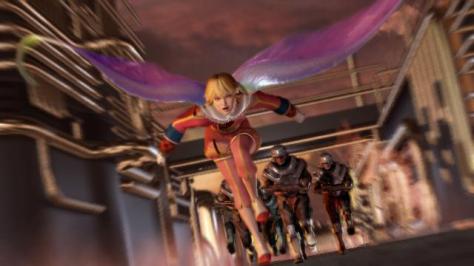
Baten Kaitos: Eternal Wings and the Lost Ocean is a role-playing game released in late 2004 for the GameCube. It was co-developed by Monolith Soft (known for the Xenosaga series and the recently released Xenoblade Chronicles) and tri-Crescendo (Eternal Sonata) and published by Namco. The game is a story of revenge for Kalas, the primary protagonist but it also focuses on his (and his compatriots) quest to save the world. I didn’t find the story or characters interesting, but what’s exceptional about the game is its card-based battle system, which could’ve been its biggest liability.
Baten Kaitos: Eternal Wings and the Lost Ocean takes place in a fantastical world, a world where landmasses float in the sky, oceans are a thing of legend, and the human inhabitants have wings. The young adult Kalas is on a mission of revenge as he searches for the murderer of his brother and grandfather. He believes the person responsible is a soldier in the imperialistic Alfard Empire. The game begins as he awakens, confused but not suffering from amnesia, in a remote village. Soon after this point, he meets Xelha, a kind but mysterious girl who believes the Empire is on the verge of unleashing a great evil. Although Kalas believes he has no need for her, they join together as their goals run a similar course.
At the point I finished (about a dozen hours in), I had met a third party member: a rural fisherman named Gibari. He was beefed up and helpful in the rural town I found him in, but he wasn’t the sharpest tool in the shed. Beyond those three, I can’t comment on anyone else as I didn’t sink enough time into the game to meet anyone else. After joining up with Xelha, I visited another town or two and trekked through a few enemy-riddled areas, but the main focus was the routine run-ins with the Empire, which helped narrow the protagonists’ motives.

I don’t really have an opinion on the general story because I only played it for a dozen or so hours, but in that time span I already knew that I didn’t like Kalas. He was off-putting from the get go with his lack of respect for others and rudeness. Of course, naïve characters are the norm for role-playing games of this ilk; I’m sure that over the course of the estimated sixty hours of gameplay, he would mature and grow as a person. A lot of my opinion of him (and others) was based on the poor voice acting and that didn’t help in forming my opinion. It’s not necessarily that characters over or under act, instead my grievance lies with the quality of the audio – it sounds like I’m listening to people in a sound booth, as if whatever audio mixing that would remove this aura wasn’t done.
On the back of the game’s box is a quote from Nintendo Power: “It’s possibly the most beautiful GCN title ever made,” which I’d have to agree with. The game’s locales are like paintings that you walk around in, or like the PlayStation 1 era Final Fantasy games; they feature a fixed camera perspective with no player control of it. The pre-rendered backgrounds of the towns are intricately detailed and will often have animated bits and pieces, but because I wasn’t able to control the camera, navigating these areas was sometimes less than great; for instance when Kalas would walk into the background and shrink to signify distance from the camera. This isn’t a problem with Baten Kaitos, it’s just a style that I don’t prefer.

What makes Baten Kaitos unique compared to other RPGs is its reliance on Magnus (playing cards) for items, attacks, equipment, and just about anything else. Each character had a deck of cards that they used in battles. As they leveled up, the amount of cards they could put into it, as well as their hand size in battles grew.
Battles revolved around each character’s deck of Magnus. A good deck would contain a mixture of offensive, defensive, and healing cards that were suited to take advantage of enemies’ elemental weaknesses. In battles, characters would have a hand of cards and I’d try my best to link them together to create optimal attacks and defensive maneuvers. I found that if I didn’t suit my deck to each area and continually keep it fresh, I wouldn’t advance.
The Magnus weren’t just used in battles though; they were used in place of items too. Special Magnus could capture the essence of an item, say water, and I could then use that Magnus to solve a puzzle, such as putting out a fire. I had to be careful with Magnus however, as the cards would age and their properties would change. For instance, if I had a Magnus with green bananas on it, as time passed, the bananas would ripen and the card’s effect would change. This aspect of the Magnus kept me on my toes and was in some instances, annoying.

Card-battling games have a reputation for being obtuse, complicated, and slow-paced. Of course, they’re also known for requiring strategy, skill, and a little luck. What’s great about Baten Kaitos: Eternal Wings and the Lost Ocean is that it takes the best things about card-battling games: strategy in deck building, skillful combinations of cards, and a little luck of the draw, while reducing the negatives by speeding up the battle system and easing players into the extensive number of Magnus. It may not have captured my attention for too long, but damned if I didn’t absolutely enjoy its battle system.
It does sound fun. I don’t like card based battle systems, but I might give this game a shot.
LikeLike
I usually don’t either, but Baten Kaitos defied expectations.
LikeLike